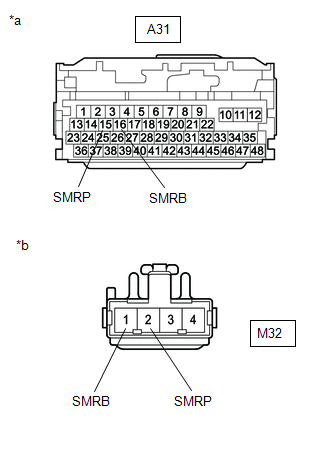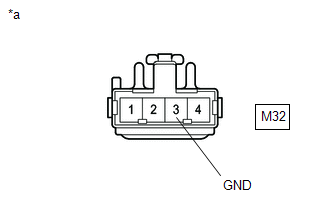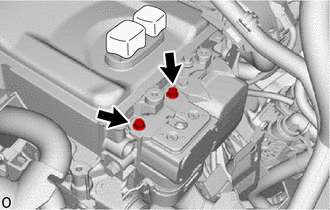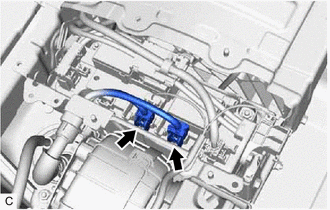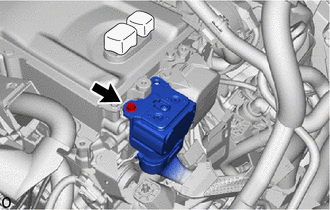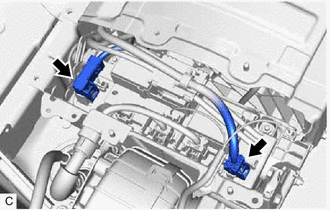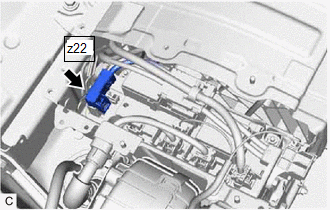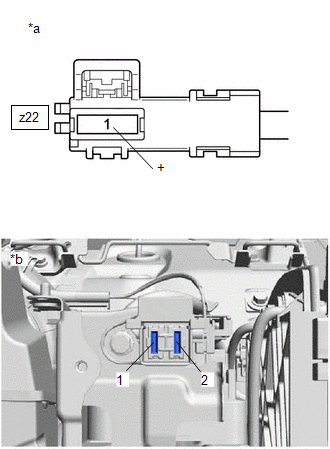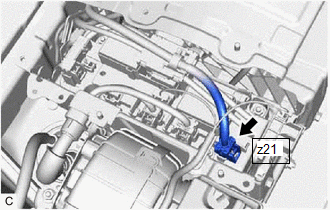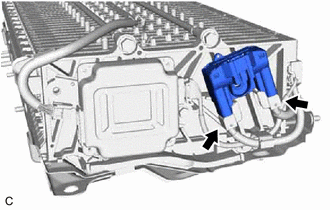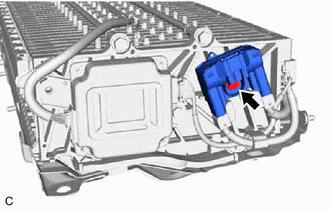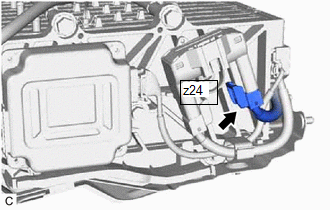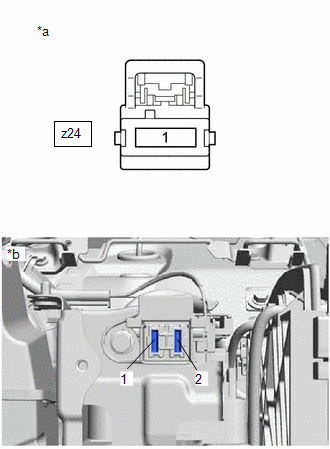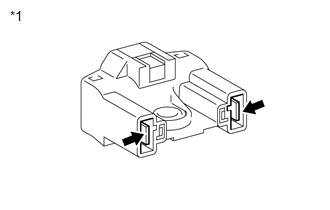- Hybrid Battery Voltage
- Hybrid Battery Current
- VL-Voltage before Boosting
- VH-Voltage after Boosting
| Last Modified: 01-30-2024 | 6.11:8.1.0 | Doc ID: RM10000000219L7 |
| Model Year Start: 2022 | Model: RAV4 HV | Prod Date Range: [12/2021 - ] |
| Title: HYBRID / BATTERY CONTROL: HYBRID CONTROL SYSTEM (for AWD with NICKEL METAL HYDRIDE BATTERY): P300449; High Voltage Power Resource Circuit Short during Pre-Charge; 2022 - 2024 MY RAV4 HV [12/2021 - ] | ||
|
DTC |
P300449 |
High Voltage Power Resource Circuit Short during Pre-Charge |
DTC SUMMARY
MALFUNCTION DESCRIPTION
The hybrid vehicle control ECU assembly monitors the high-voltage wiring between the HV battery and inverter with converter assembly and detects an open circuit malfunction.
The cause of this malfunction may be one of the following:
Inverter voltage sensor (VH) internal circuit malfunction
- Voltage sensor (VH) malfunction
- Motor generator control ECU (MG ECU) malfunction
- Communication (wire harness) malfunction
High voltage system malfunction
- HV battery malfunction
- HV battery junction block assembly malfunction
- Inverter with converter assembly malfunction
- High-voltage wire harness malfunction
- High-voltage connector or connection malfunction
Low-voltage circuit (12 V) malfunction
- Hybrid vehicle control ECU assembly malfunction
- HV battery junction block assembly malfunction
- Low voltage wire harness malfunction
- Low voltage connector malfunction
INSPECTION DESCRIPTION
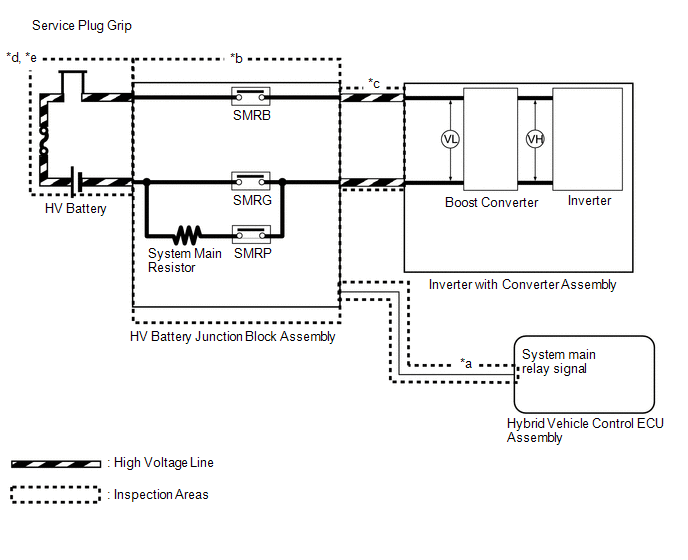
|
System Diagram Range |
Inspection Content |
Reason |
Inspection Step |
|---|---|---|---|
|
*a |
Check connection condition and wire harness continuity between hybrid vehicle control ECU assembly and HV battery junction block assembly |
Check whether connectors are connected properly and check for an open circuit in the SMRP and SMRB primary lines |
3 to 7 |
|
*b |
Check system main relay |
Check whether SMRB and SMRP stuck OFF |
8, 9 |
|
*c |
Check connection condition and high-voltage cable continuity between HV battery junction block assembly and inverter with converter assembly |
Check for open circuit and defective connection (arc marks) due to looseness |
10 to 12 |
|
*d |
Check high-voltage cable and connection condition between HV battery and HV battery junction block assembly |
Check for open circuit and defective connection (arc marks) due to looseness |
13, 14, 19, 20, 21 |
|
*e |
Check HV battery |
Check whether HV battery voltage has drastically dropped below normal range |
15 |
DESCRIPTION
Refer to the description for DTC P0AE411.
The hybrid vehicle control ECU assembly monitors the high-voltage wiring between the HV battery and the inverter with converter assembly and detects the following malfunction.
|
DTC No. |
Detection Item |
DTC Detection Condition |
Trouble Area |
MIL |
Warning Indicate |
|---|---|---|---|---|---|
|
P300449 |
High Voltage Power Resource Circuit Short during Pre-Charge |
Although a system main relay operation signal was sent when the ignition switch was operated, the system voltage is not sufficiently increased after boosting and the HV battery current does not flow. High-voltage circuit malfunctions between the HV battery and inverter with converter assembly. The EV electric battery fuse is blown, the service plug grip is removed, the system main resistor is blown, SMRP or SMRB remains open, or the high-voltage cable has an open circuit. (2 trip detection logic) |
|
Does not come on |
Master Warning: Comes on |
Related Data List
|
DTC No. |
Data List |
|---|---|
|
P300449 |
|
The following items can be helpful when performing repairs:
Data List
- Ready Signal
- Inter Lock Switch
- SMRP Status
- SMRB Status
- SMRG Status
CONFIRMATION DRIVING PATTERN
HINT:
After repair has been completed, clear the DTC and then check that the vehicle has returned to normal by performing the following All Readiness check procedure.
- Connect the Techstream to the DLC3.
- Turn the ignition switch to ON and turn the Techstream on.
- Clear the DTCs (even if no DTCs are stored, perform the clear DTC procedure).
- Turn the ignition switch off and wait for 2 minutes or more.
- Turn the ignition switch to ON and turn the Techstream on.
-
Turn the ignition switch to ON (READY) and wait for 3 minutes or more.
HINT:
According to the display on the Techstream, read the Data List and monitor the values of "Hybrid Battery Voltage" and "VL-Voltage before Boosting" for 3 minutes. If the difference between "Hybrid Battery Voltage" and "VL-Voltage before Boosting" is always less than 50 V, the vehicle has returned to normal.
- Enter the following menus: Powertrain / Hybrid Control / Utility / All Readiness.
-
Check the DTC judgment result.
HINT:
- If the judgment result shows NORMAL, the system is normal.
- If the judgment result shows ABNORMAL, the system has a malfunction.
- If the judgment result shows INCOMPLETE, perform driving pattern again.
WIRING DIAGRAM
Refer to the wiring diagram for DTC P0AA649.
Refer to the wiring diagram for the HV battery high-voltage line circuit.
CAUTION / NOTICE / HINT
CAUTION:
-
Before the following operations are conducted, take precautions to prevent electric shock by turning the ignition switch off, wearing insulated gloves, and removing the service plug grip from HV battery.
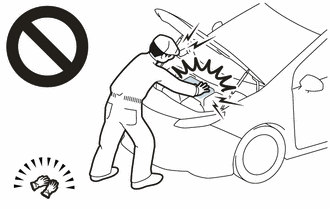
- Inspecting the high-voltage system
- Disconnecting the low voltage connector of the inverter with converter assembly
- Disconnecting the low voltage connector of the HV battery
-
To prevent electric shock, make sure to remove the service plug grip to cut off the high voltage circuit before servicing the vehicle.
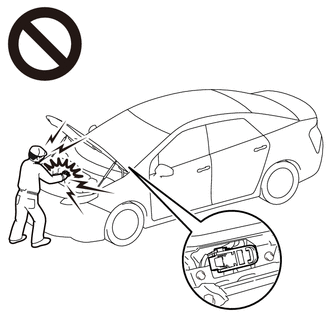
-
After removing the service plug grip from the HV battery, put it in your pocket to prevent other technicians from accidentally reconnecting it while you are working on the high-voltage system.
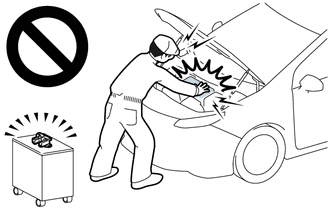
-
After removing the service plug grip, wait for at least 10 minutes before touching any of the high-voltage connectors or terminals. After waiting for 10 minutes, check the voltage at the terminals in the inspection point in the inverter with converter assembly. The voltage should be 0 V before beginning work.
HINT:
Waiting for at least 10 minutes is required to discharge the high-voltage capacitor inside the inverter with converter assembly.
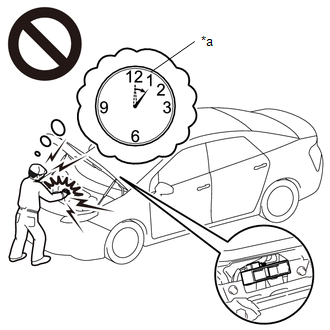
*a
Without waiting for 10 minutes
-
Make sure to insulate the high-voltage connectors and terminals of the HV battery with insulating tape after removing it.
If the HV battery stored without insulating the connectors and terminals, electric shock or fire may result.
-
When disposing of an HV battery, make sure to return it through an authorized collection agent who is capable of handling it safely. If the HV battery is returned via the manufacturer specified route, it will be returned properly and in a safe manner by an authorized collection agent.
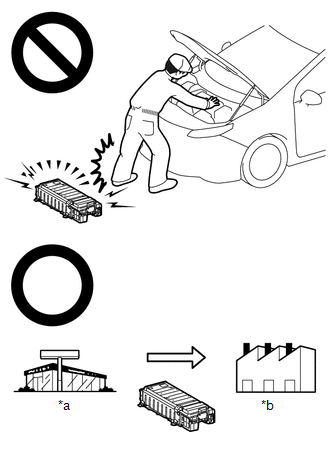
*a
Dealer
*b
Battery Collection Agent
- Before returning the HV battery, make sure to perform a recovery inspection.
- Make a note of the output DTCs as some of them may be necessary for recovery inspection of the HV battery.
NOTICE:
After turning the ignition switch off, waiting time may be required before disconnecting the cable from the negative (-) auxiliary battery terminal. Therefore, make sure to read the disconnecting the cable from the negative (-) auxiliary battery terminal notices before proceeding with work.
PROCEDURE
|
1. |
CHECK DTC OUTPUT (HYBRID CONTROL, MOTOR GENERATOR) |
(a) Connect the Techstream to the DLC3.
(b) Turn the ignition switch to ON.
(c) Enter the following menus: Powertrain / Hybrid Control and Motor Generator / Trouble Codes.
(d) Check for DTCs.
Powertrain > Hybrid Control > Trouble Codes
Powertrain > Motor Generator > Trouble Codes
|
Result |
Proceed to |
|---|---|
|
P300449 only is output, or DTCs except the ones in the table below are also output. |
A |
|
DTCs of hybrid control system in the tables below are output. |
B |
|
DTCs of motor generator control system in the tables below are output. |
C |
|
Malfunction Content |
System |
Relevant DTC |
|
|---|---|---|---|
|
Microcomputer malfunction |
Hybrid control system |
P0A1B49 |
Drive Motor "A" Control Module Internal Electronic Failure |
|
P060647 |
Hybrid/EV Powertrain Control Module Processor Watchdog / Safety MCU Failure |
||
|
P060687 |
Hybrid/EV Powertrain Control Module Processor to Monitoring Processor Missing Message |
||
|
P060A47 |
Hybrid/EV Powertrain Control Module Monitoring Processor Watchdog / Safety MCU Failure |
||
|
P060A87 |
Hybrid/EV Powertrain Control Module Processor from Monitoring Processor Missing Message |
||
|
P1C9E9F |
Hybrid/EV System Reset Stuck Off |
||
|
P0AFC96 |
Hybrid/EV Battery Sensor Module Component Internal Failure |
||
|
P0AFC00 |
Hybrid/EV Battery Sensor Module |
||
|
Motor generator control system |
P0A1B1F |
Generator Control Module Circuit Intermittent |
|
|
P0A1A47 |
Generator Control Module Watchdog / Safety MC Failure |
||
|
P0A1A49 |
Generator Control Module Internal Electronic Failure |
||
|
P1C2A1C |
Generator A/D Converter Circuit Circuit Voltage Out of Range |
||
|
P1C2A49 |
Generator A/D Converter Circuit Internal Electronic Failure |
||
|
P313383 |
Communication Error from Generator to Drive Motor "A" Value of Signal Protection Calculation Incorrect |
||
|
P313386 |
Communication Error from Generator to Drive Motor "A" Signal Invalid |
||
|
P313387 |
Communication Error from Generator to Drive Motor "A" Missing Message |
||
|
Power source circuit malfunction |
Hybrid control system |
P0AFC16 |
Hybrid/EV Battery Sensor Module Circuit Voltage Below Threshold |
|
Motor generator control system |
P06D61C |
Generator Control Module Offset Power Circuit Voltage Out of Range |
|
|
Communication system malfunction |
Hybrid control system |
P312387 |
Lost Communication with Drive Motor Control Module "A" from Hybrid/EV Control Module Missing Message |
|
U029A87 |
Lost Communication with Hybrid/EV Battery Sensor Module Missing Message |
||
|
Sensor and actuator circuit malfunction |
Hybrid control system |
P0AD915 |
Hybrid/EV Battery Positive Contactor Circuit Short to Auxiliary Battery or Open |
|
P0AD911 |
Hybrid/EV Battery Positive Contactor Circuit Short to Ground |
||
|
P0AE415 |
Hybrid/EV Battery Precharge Contactor Circuit Short to Auxiliary Battery or Open |
||
|
P0AE411 |
Hybrid/EV Battery Precharge Contactor Circuit Short to Ground |
||
|
P0ADD15 |
Hybrid/EV Battery Negative Contactor Circuit Short to Auxiliary Battery or Open |
||
|
P0ADD11 |
Hybrid/EV Battery Negative Contactor Circuit Short to Ground |
||
|
P0ABF11 |
Hybrid/EV Battery Current Sensor "A" Circuit Short to Ground |
||
|
P0ABF15 |
Hybrid/EV Battery Current Sensor "A" Circuit Short to Auxiliary Battery or Open |
||
|
P0B3B14 |
Hybrid/EV Battery Voltage Sensor "A" Circuit Short to Ground or Open |
||
|
P0B4014 |
Hybrid/EV Battery Voltage Sensor "B" Circuit Short to Ground or Open |
||
|
P0B4514 |
Hybrid/EV Battery Voltage Sensor "C" Circuit Short to Ground or Open |
||
|
P0B4A14 |
Hybrid/EV Battery Voltage Sensor "D" Circuit Short to Ground or Open |
||
|
P0B4F14 |
Hybrid/EV Battery Voltage Sensor "E" Circuit Short to Ground or Open |
||
|
P0B5414 |
Hybrid/EV Battery Voltage Sensor "F" Circuit Short to Ground or Open |
||
|
P0B5914 |
Hybrid/EV Battery Voltage Sensor "G" Circuit Short to Ground or Open |
||
|
P0B5E14 |
Hybrid/EV Battery Voltage Sensor "H" Circuit Short to Ground or Open |
||
|
P0B6314 |
Hybrid/EV Battery Voltage Sensor "I" Circuit Short to Ground or Open |
||
|
P0B6814 |
Hybrid/EV Battery Voltage Sensor "J" Circuit Short to Ground or Open |
||
|
P0B6D14 |
Hybrid/EV Battery Voltage Sensor "K" Circuit Short to Ground or Open |
||
|
P0B7214 |
Hybrid/EV Battery Voltage Sensor "L" Circuit Short to Ground or Open |
||
|
P308A13 |
Hybrid/EV Battery Voltage Sensor All Circuit Open |
||
|
P0AFC62 |
Hybrid/EV Battery Sensor Module Signal Compare Failure |
||
|
P0B231C |
Hybrid/EV Battery "A" Voltage Sensor Voltage Out of Range |
||
|
P308A12 |
Hybrid/EV Battery Voltage Sensor All Circuit Short to Auxiliary Battery |
||
|
P0ABF00 |
Hybrid/EV Battery Current Sensor "A" Circuit Range/Performance |
||
|
P0ABF28 |
Hybrid/EV Battery Current Sensor "A" Signal Bias Level Out of Range / Zero Adjustment Failure |
||
|
P0ABF2A |
Hybrid/EV Battery Current Sensor "A" Signal Stuck In Range |
||
|
System malfunction |
Hybrid control system |
P0C7600 |
Hybrid/EV Battery System Discharge Time Too Long |
|
P0D2D1C |
Drive Motor "A" Inverter Voltage Sensor Voltage Out of Range |
||
|
P1C8149 |
High Voltage Power Resource Circuit Consumption Circuit Short |
||
|
P1C8249 |
High Voltage Power Resource Circuit Over Loading |
||
|
P1C8349 |
High Voltage Power Resource Circuit Voltage Sensor after Boosting Malfunction |
||
|
Motor generator control system |
P0D2D16 |
Drive Motor "A" Inverter Voltage Sensor(VH) Circuit Voltage Below Threshold |
|
|
P0D2D17 |
Drive Motor "A" Inverter Voltage Sensor(VH) Circuit Voltage Above Threshold |
||
|
P1CB69E |
Drive Motor "A" Inverter Voltage Sensor(VH) Stuck On |
||
|
P0CA300 |
DC/DC Converter Step Up Voltage Performance |
||
HINT:
-
P300449 may be output as a result of the malfunction indicated by the DTCs above.
- The chart above is listed in inspection order of priority.
- Check DTCs that are output at the same time by following the listed order. (The main cause of the malfunction can be determined without performing unnecessary inspections.)
(e) Turn the ignition switch off.
| B |

|
| C |

|
|
|
2. |
CHECK FREEZE FRAME DATA (HYBRID CONTROL) |
(a) Connect the Techstream to the DLC3.
(b) Turn the ignition switch to ON.
(c) Enter the following menus: Powertrain / Hybrid Control / Trouble Codes.
(d) Read the freeze frame data of DTC P300449.
Powertrain > Hybrid Control > Trouble Codes
Standard:
|
Freeze Frame Data Itm |
Specified Condition |
|---|---|
|
VH-Voltage after Boosting |
Below 50 V [*1] |
|
Hybrid/EV Battery Voltage - VL-Voltage before Boosting |
-40 to 40 V [*2] |
|
Result |
Cause |
Proceed to |
|---|---|---|
|
Specified condition [*1] and [*2] are met |
Inverter |
A |
|
Except above |
Other |
B |
(e) Turn the ignition switch off.
| A |

|
|
|
3. |
CHECK CONNECTOR CONNECTION CONDITION (HYBRID VEHICLE CONTROL ECU ASSEMBLY CONNECTOR) |
| NG |

|
CONNECT SECURELY |
|
|
4. |
CHECK CONNECTOR CONNECTION CONDITION (FLOOR WIRE CONNECTOR) |
|
Result |
Proceed to |
|---|---|
|
OK |
A |
|
NG (The connector is not connected securely.) |
B |
|
NG (The terminals are not making secure contact or are deformed, or water or foreign matter exists in the connector.) |
C |
| B |

|
CONNECT SECURELY |
| C |

|
REPAIR OR REPLACE HARNESS OR CONNECTOR |
|
|
5. |
CHECK CONNECTOR CONNECTION CONDITION (HV BATTERY JUNCTION BLOCK ASSEMBLY CONNECTOR) |
| NG |

|
CONNECT SECURELY |
|
|
6. |
CHECK HARNESS AND CONNECTOR (HYBRID VEHICLE CONTROL ECU ASSEMBLY - HV BATTERY JUNCTION BLOCK ASSEMBLY) |
CAUTION:
Be sure to wear insulated gloves.
(a) Check that the service plug grip is not installed.
NOTICE:
After removing the service plug grip, do not turn the ignition switch to ON (READY), unless instructed by the repair manual because this may cause a malfunction.
(b) Remove the No. 1 HV battery cover panel RH.
(c) Disconnect the M32 HV battery junction block assembly connector.
(d) Disconnect the A31 hybrid vehicle control ECU assembly connector.
|
(e) Measure the resistance according to the value(s) in the table below. Standard Resistance:
|
|
(f) Reconnect the A31 hybrid vehicle control ECU assembly connector.
(g) Reconnect the M32 HV battery junction block assembly connector.
(h) Install the No. 1 HV battery cover panel RH.
| NG |

|
REPAIR OR REPLACE HARNESS OR CONNECTOR |
|
|
7. |
CHECK HARNESS AND CONNECTOR (HV BATTERY JUNCTION BLOCK ASSEMBLY - BODY GROUND) |
CAUTION:
Be sure to wear insulated gloves.
(a) Check that the service plug grip is not installed.
NOTICE:
After removing the service plug grip, do not turn the ignition switch to ON (READY), unless instructed by the repair manual because this may cause a malfunction.
(b) Remove the No. 1 HV battery cover panel RH.
(c) Disconnect the M32 HV battery junction block assembly connector.
|
(d) Measure the resistance according to the value(s) in the table below. Standard Resistance:
|
|
(e) Reconnect the M32 HV battery junction block assembly connector.
(f) Install the No. 1 HV battery cover panel RH.
| NG |

|
REPAIR OR REPLACE HARNESS OR CONNECTOR |
|
|
8. |
INSPECT HV BATTERY JUNCTION BLOCK ASSEMBLY (SMRB) |
CAUTION:
Be sure to wear insulated gloves.
(a) Check that the service plug grip is not installed.
NOTICE:
After removing the service plug grip, do not turn the ignition switch to ON (READY), unless instructed by the repair manual because this may cause a malfunction.
(b) Remove the HV battery junction block assembly.
(c) Measure the resistance according to the value(s) in the table below.
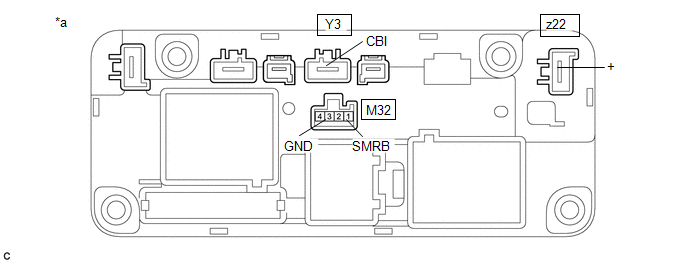
|
*a |
Component without harness connected (HV Battery Junction Block Assembly) |
- |
- |
Standard Resistance:
|
Tester Connection |
Condition |
Specified Condition |
|---|---|---|
|
z22-1 (+) - Y3-1 (CBI) |
Auxiliary battery voltage applied between terminals M32-1 (SMRB) and M32-3 (GND) |
Below 1 Ω |
(d) Measure the resistance according to the value(s) in the table below.
Standard Resistance:
|
Tester Connection |
Condition |
Specified Condition |
|---|---|---|
|
M32-1 (SMRB) - M32-3 (GND) |
-40 to 80°C (-40 to 176°F) |
25.0 to 59.0 Ω |
(e) Install the HV battery junction block assembly.
| NG |

|
|
|
9. |
INSPECT HV BATTERY JUNCTION BLOCK ASSEMBLY (SMRP) |
CAUTION:
Be sure to wear insulated gloves.
(a) Check that the service plug grip is not installed.
NOTICE:
After removing the service plug grip, do not turn the ignition switch to ON (READY), unless instructed by the repair manual because this may cause a malfunction.
(b) Remove the HV battery junction block assembly.
(c) Measure the resistance according to the value(s) in the table below.
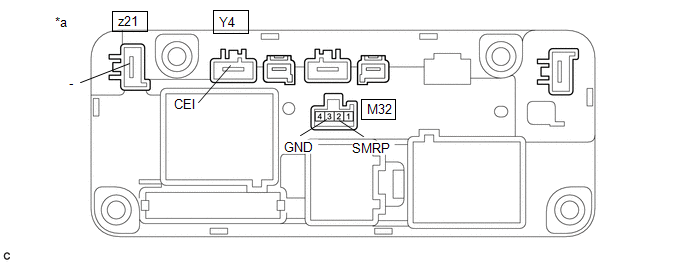
|
*a |
Component without harness connected (HV Battery Junction Block Assembly) |
- |
- |
Standard Resistance:
|
Tester Connection |
Condition |
Specified Condition |
|---|---|---|
|
z21-1 (-) - Y4-1 (CEI) |
Auxiliary battery voltage applied between terminals M32-2 (SMRP) and M32-3 (GND) |
24.3 to 29.7 Ω |
(d) Measure the resistance according to the value(s) in the table below.
Standard Resistance:
|
Tester Connection |
Condition |
Specified Condition |
|---|---|---|
|
M32-2 (SMRP) - M32-3 (GND) |
-40 to 80°C (-40 to 176°F) |
140 to 290 Ω |
(e) Install the HV battery junction block assembly.
| NG |

|
|
|
10. |
CHECK INVERTER WITH CONVERTER ASSEMBLY (HV FLOOR UNDER WIRE) |
CAUTION:
Be sure to wear insulated gloves.
(a) Check that the service plug grip is not installed.
NOTICE:
After removing the service plug grip, do not turn the ignition switch to ON (READY), unless instructed by the repair manual because this may cause a malfunction.
|
(b) Check that the bolts for the HV floor under wire are tightened to the specified torque, the HV floor under wire is connected securely, and there are no contact problems. Specified Condition: T = 8.0 N*m (82 kgf*cm, 71 in.*lbf) |
|
(c) Disconnect the HV floor under wire from the inverter with converter assembly.
(d) Check for arc marks on the terminals for the HV floor under wire and inverter with converter assembly.
|
Result |
Proceed to |
|
|---|---|---|
|
The terminals are connected securely and there are no contact problems. |
There are no arc marks. |
A |
|
The terminals are not connected securely and there is a contact problem. |
There are arc marks. |
B |
|
The terminals are not connected securely and there is a contact problem. |
There are no arc marks. |
C |
|
The terminals are connected securely and there are no contact problems. |
There are arc marks. |
B |
(e) Reconnect the HV floor under wire.
| B |

|
REPLACE MALFUNCTIONING PARTS |
| C |

|
CONNECT SECURELY |
|
|
11. |
CHECK HV BATTERY JUNCTION BLOCK ASSEMBLY (HV FLOOR UNDER WIRE) |
CAUTION:
Be sure to wear insulated gloves.
(a) Check that the service plug grip is not installed.
NOTICE:
After removing the service plug grip, do not turn the ignition switch to ON (READY), unless instructed by the repair manual because this may cause a malfunction.
(b) Remove the No. 1 HV battery cover panel RH.
|
(c) Check that the HV floor under wire is connected securely, and there are no contact problems. |
|
(d) Disconnect the HV floor under wire connectors from the HV battery junction block assembly.
(e) Check for arc marks on the terminals of the HV floor wire and the HV battery junction block assembly.
|
Result |
Proceed to |
|
|---|---|---|
|
The terminals are connected securely and there are no contact problems. |
There are no arc marks. |
A |
|
The terminals are not connected securely and there is a contact problem. |
There are arc marks. |
B |
|
The terminals are not connected securely and there is a contact problem. |
There are no arc marks. |
C |
|
The terminals are connected securely and there are no contact problems. |
There are arc marks. |
B |
(f) Reconnect the HV floor under wire.
(g) Install the No. 1 HV battery cover panel RH.
| B |

|
REPLACE MALFUNCTIONING PARTS |
| C |

|
CONNECT SECURELY |
|
|
12. |
CHECK FLOOR UNDER WIRE |
CAUTION:
Be sure to wear insulated gloves.
(a) Check that the service plug grip is not installed.
NOTICE:
After removing the service plug grip, do not turn the ignition switch to ON (READY), unless instructed by the repair manual because this may cause a malfunction.
(b) Remove the No. 1 HV battery cover panel RH.
|
(c) Disconnect the HV floor under wire connectors from the HV battery junction block assembly. |
|
|
(d) Disconnect the HV floor under wire connector from the inverter with converter assembly. |
|
(e) Measure the resistance according to the value(s) in the table below.
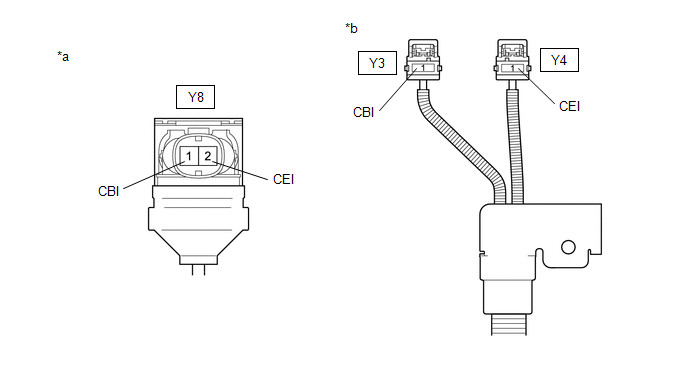
|
*a |
HV Floor Under Wire (Inverter with Converter Assembly Side) |
*b |
HV Floor Under Wire (HV Battery Junction Block Assembly Side) |
Standard Resistance:
|
Tester Connection |
Condition |
Specified Condition |
|---|---|---|
|
Y8-1 (CBI) - Y3-1 (CBI) |
Ignition switch off |
Below 1 Ω |
|
Y8-2 (CEI) - Y4-1 (CEI) |
Ignition switch off |
Below 1 Ω |
NOTICE:
Be sure not to damage or deform the terminal being inspected.
(f) Reconnect the HV floor under wire connector to the inverter with converter assembly.
(g) Reconnect the HV floor under wire connectors to the HV battery junction block assembly.
(h) Install the No. 1 HV battery cover panel RH.
| NG |

|
|
|
13. |
CHECK HV BATTERY JUNCTION BLOCK ASSEMBLY (HV BATTERY HIGH VOLTAGE CONNECTOR CONNECTION CONDITION) |
CAUTION:
Be sure to wear insulated gloves.
(a) Check that the service plug grip is not installed.
NOTICE:
After removing the service plug grip, do not turn the ignition switch to ON (READY), unless instructed by the repair manual because this may cause a malfunction.
(b) Remove the No. 1 HV battery cover panel RH.
|
(c) Check the 2 HV battery high voltage connectors are connected securely, and there are no contact problems. |
|
(d) Disconnect the 2 HV battery high voltage connectors from the HV battery junction block assembly.
NOTICE:
Insulate each disconnected high-voltage connector with insulating tape. Wrap the connector from the wire harness side to the end of the connector.
(e) Check for arc marks on the terminals of the HV battery high voltage connectors and HV battery junction block assembly.
|
Result |
Proceed to |
|
|---|---|---|
|
The terminals are connected securely and there are no contact problems. |
There are no arc marks. |
A |
|
The terminals are not connected securely and there is a contact problem. |
There are arc marks. |
B |
|
The terminals are not connected securely and there is a contact problem. |
There are no arc marks. |
C |
|
The terminals are connected securely and there are no contact problems. |
There are arc marks. |
B |
(f) Reconnect the 2 HV battery high voltage connectors.
(g) Install the No. 1 HV battery cover panel RH.
| B |

|
REPLACE MALFUNCTIONING PARTS |
| C |

|
CONNECT SECURELY |
|
|
14. |
CHECK HV BATTERY HIGH VOLTAGE CABLE |
CAUTION:
Be sure to wear insulated gloves.
(a) Check that the service plug grip is not installed.
NOTICE:
After removing the service plug grip, do not turn the ignition switch to ON (READY), unless instructed by the repair manual because this may cause a malfunction.
(b) Remove the No. 1 HV battery cover panel RH.
|
(c) Disconnect the z22 HV battery high voltage cable connector from the HV battery junction block assembly. NOTICE: Insulate each disconnected high-voltage connector with insulating tape. Wrap the connector from the wire harness side to the end of the connector. |
|
|
(d) Measure the resistance according to the value(s) in the table below. Standard Resistance:
|
|
(e) Reconnect the z22 HV battery high voltage cable connector.
(f) Install the No. 1 HV battery cover panel RH.
| NG |

|
|
|
15. |
CHECK HV BATTERY |
CAUTION:
Be sure to wear insulated gloves.
(a) Check that the service plug grip is not installed.
NOTICE:
After removing the service plug grip, do not turn the ignition switch to ON (READY), unless instructed by the repair manual because this may cause a malfunction.
(b) Remove the No. 1 HV battery cover panel RH.
|
(c) Disconnect the z21 HV battery high voltage cable connector from the HV battery junction block assembly. NOTICE: Insulate each disconnected high-voltage connector with insulating tape. Wrap the connector from the wire harness side to the end of the connector. |
|
|
(d) Measure the voltage according to the value(s) in the table below. Standard Voltage:
CAUTION: Do not allow the probes of the electrical tester to contact each other during this inspection. |
|
(e) Reconnect the z21 HV battery high voltage cable connector.
(f) Install the No. 1 HV battery cover panel RH.
| NG |

|
|
|
16. |
CHECK FOR INTERMITTENT PROBLEMS |
(a) Check for intermittent problems.
|
Result |
Proceed to |
|---|---|
|
Problem symptom does not recur. |
A |
|
Problem symptom recurs. |
B |
HINT:
- Since 2 trip detection logic is used, the DTC detection condition must be met twice.
- If DTC P300449 is output again after performing the inspection, replace the inverter with converter assembly. If DTC P300449 is not output again, replace the HV battery junction block assembly.
| B |

|
|
|
17. |
REPLACE HV BATTERY JUNCTION BLOCK ASSEMBLY |
|
|
18. |
CHECK HYBRID VEHICLE CONTROL ECU ASSEMBLY (CHECK FOR NORMAL OPERATION) |
|
Result |
Proceed to |
|---|---|
|
Difference between "Hybrid Battery Voltage" and "VL-Voltage before Boosting" is always less than 50 V. |
A |
|
Difference between "Hybrid Battery Voltage" and "VL-Voltage before Boosting" is 50 V or more. |
B |
| A |

|
END |
| B |

|
|
19. |
CHECK HYBRID BATTERY TERMINAL BLOCK (HV BATTERY HIGH VOLTAGE CONNECTOR CONNECTION CONDITION) |
CAUTION:
Be sure to wear insulated gloves and protective goggles.
(a) Check that the service plug grip is not installed.
NOTICE:
After removing the service plug grip, do not turn the ignition switch to ON (READY), unless instructed by the repair manual because this may cause a malfunction.
(b) Remove the No. 1 HV battery shield panel.
|
(c) Check that the 2 HV battery high voltage connectors are connected securely, and there are no contact problems. |
|
(d) Remove the hybrid battery terminal block.
NOTICE:
Insulate each disconnected high-voltage connector with insulating tape. Wrap the connector from the wire harness side to the end of the connector.
(e) Check for arc marks on the terminals of the HV battery high voltage connectors and hybrid battery terminal block.
|
Result |
Proceed to |
|
|---|---|---|
|
The terminals are connected securely and there are no contact problems. |
There are no arc marks. |
A |
|
The terminals are not connected securely and there is a contact problem. |
There are arc marks. |
B |
|
The terminals are not connected securely and there is a contact problem. |
There are no arc marks. |
C |
|
The terminals are connected securely and there are no contact problems. |
There are arc marks. |
B |
(f) Install the hybrid battery terminal block.
(g) Install the No. 1 HV battery shield panel.
| B |

|
REPLACE MALFUNCTIONING PARTS |
| C |

|
CONNECT SECURELY |
|
|
20. |
CHECK HV BATTERY HIGH VOLTAGE CABLE |
CAUTION:
Be sure to wear insulated gloves and protective goggles.
(a) Check that the service plug grip is not installed.
NOTICE:
After removing the service plug grip, do not turn the ignition switch to ON (READY), unless instructed by the repair manual because this may cause a malfunction.
(b) Remove the No. 1 HV battery shield panel.
|
(c) Remove the bolt from the hybrid battery terminal block. |
|
|
(d) Disconnect the z24 high voltage connector from the hybrid battery terminal block. NOTICE: Insulate each disconnected high-voltage connector with insulating tape. Wrap the connector from the wire harness side to the end of the connector. |
|
|
(e) Measure the resistance according to the value(s) in the table below. Standard Resistance:
|
|
(f) Reconnect the z24 high voltage connector to the hybrid battery terminal block.
(g) Install the bolt to the hybrid battery terminal block.
(h) Install the No. 1 HV battery shield panel.
| NG |

|
|
|
21. |
CHECK HYBRID BATTERY TERMINAL BLOCK |
CAUTION:
Be sure to wear insulated gloves and protective goggles.
(a) Remove the Hybrid battery terminal block.
|
(b) Measure the resistance according to the value(s) in the table below. Standard Resistance:
|
|
(c) Install the Hybrid battery terminal block.
| OK |

|
| NG |

|
|
|
|
![2019 - 2024 MY RAV4 HV [02/2019 - ]; HYBRID / BATTERY CONTROL: HYBRID CONTROL SYSTEM (for AWD with NICKEL METAL HYDRIDE BATTERY): P0AE411; Hybrid/EV Battery Precharge Contactor Circuit Short to Ground+](/t3Portal/stylegraphics/info.gif)

